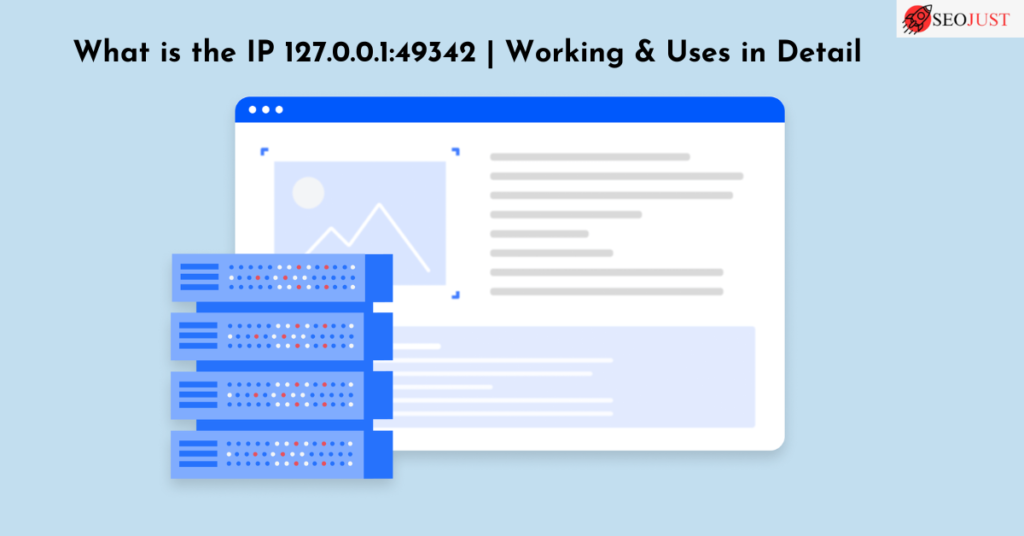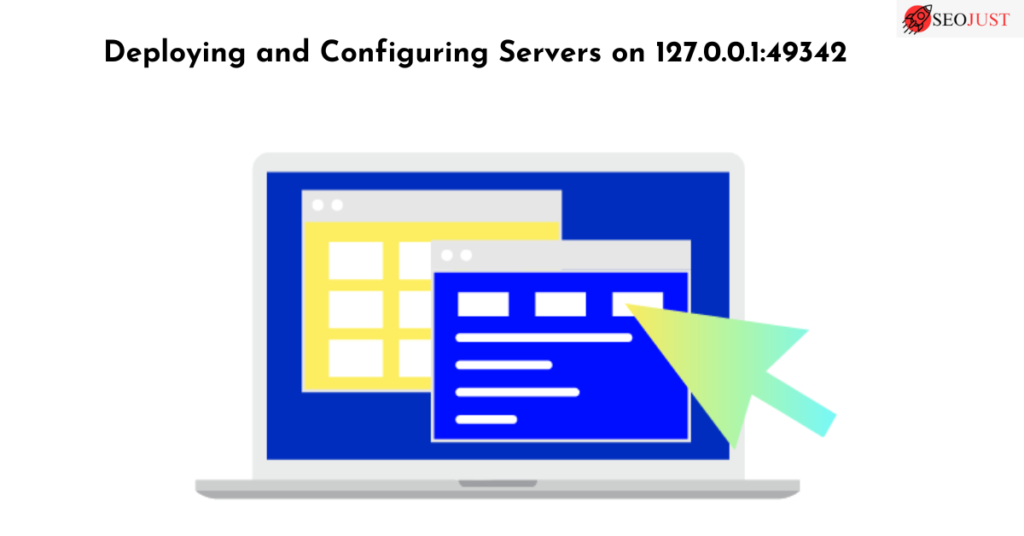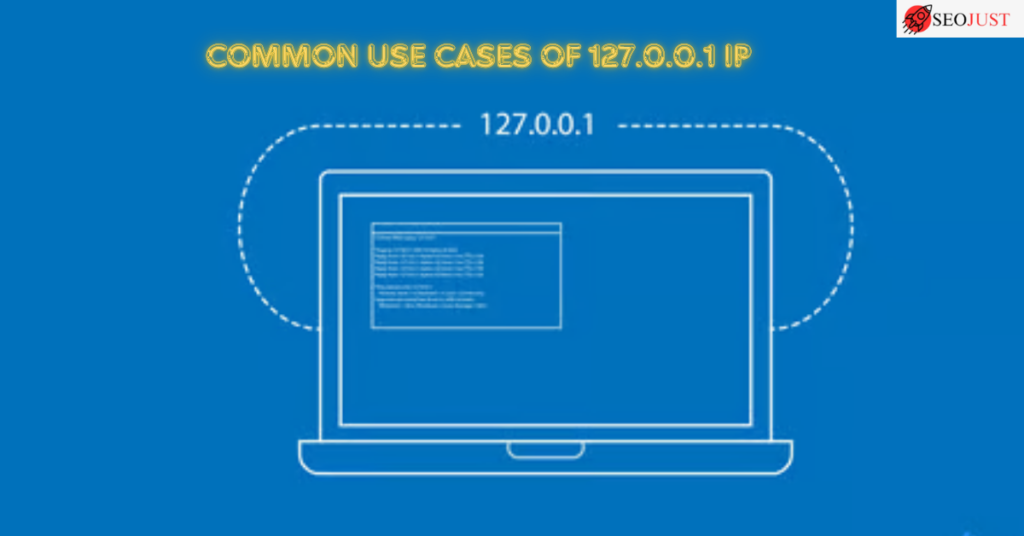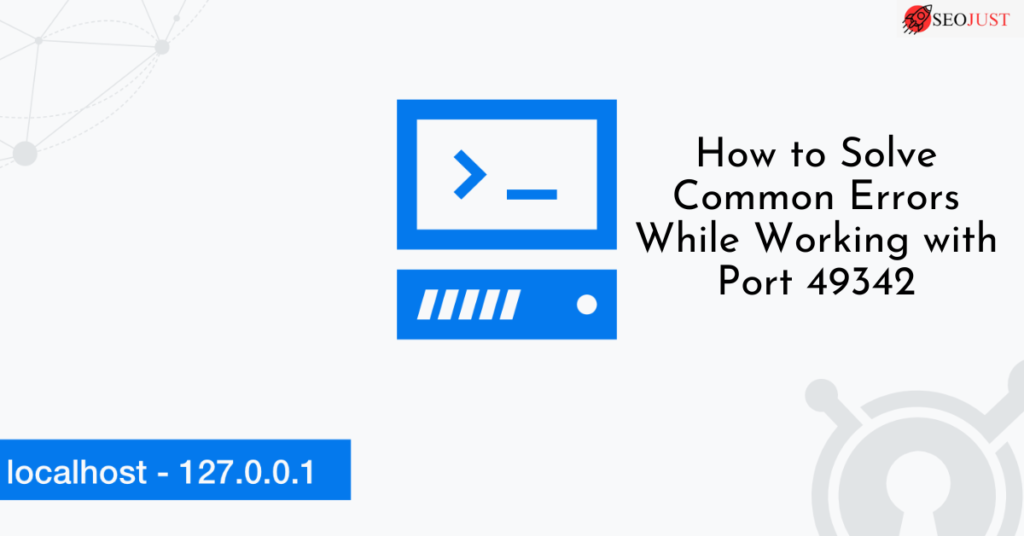IP addresses and ports are essential in network communication. The combination “127.0.0.1:49342” refers to a local address used by your device. 127.0.0.1 is the loopback address, often called “localhost.” It refers to your own device. Port 49342 is a specific port number, used by services or applications running on your machine.
As an expert of 8 years in Tech, I am always curious about ai, tech, IP, Protocols. So, I’ve studied about this IP address thoroughly, and summarized it in this blog for you! I researched up to 20+ different sites to understand the exact detail of the topic.
Without more details, it’s impossible to say exactly which service is running on port 49342. But, most commonly the port is tied to an application using that particular port to communicate on your local machine.
Read More: Get_Ready_Bell:Client_Pulse
What is the IP 127.0.0.1:49342 | Working & Uses in Detail
When we see combinations like “127.0.0.1:49342,” they can seem cryptic. But they are very common in Networking and Software development. That is how many devices and applications exchange information on a network. Any IT or development professional must know about IP addresses and ports.

I’ve answered some quick fix questions for you:
| Problem | Cause | Fix |
| Service Crash | Service froze. | Restart the service to clear issues. |
| Port Conflict | Two apps on the same port. | Change the port in one app’s settings. |
| Firewall Block | Port blocked by firewall. | Allow traffic for Port 49342. |
| Unauthorized Use | Unknown app using the port. | Use netstat/tcpview to check usage. |
| Wrong Settings | App settings misconfigured. | Check docs, verify port setup. |
How Does It Work?
If you happen to connect on the IP, your computer will know to talk to itself internally. This setup is often used by developers to have a web server or application listenting on that port.
For example, if you point your browser to http://127.0.0.1:49342 means you’re making the query, not over the internet to the real url but rather to a local machine that is run just by you.
Understanding IP Addresses
Devices within a network are identified by an IP address. There are two types:
- IPv4: Like 192.168.1.1 and the rest of them.
- IPv6: Made to accommodate more devices: a more complex format.
In this context, when we say to ourselves “127.0.0.1” it is known as ‘localhost’, which is your own machine. It is commonly used for testing or troubleshooting.
Localhost Explained: 127.0.0.1
127.0.0.1 or localhost is the term for the device itself. When you put this address into your computer, it communicates with itself. This is useful for:
- Testing web applications.
- Running without the need to bus about the network.
Understanding Ports
Just like doors, ports are like the doors applications use to send or receive data. A different service on your device corresponds to each port. Common ports include:
- 80 for HTTP (web servers).
- HTTPS (secure web servers) – 443.
In this example, 49342 is a port number. It’s a sign that another application on your device is using this port for communication.
Practical Applications of 127.0.0.1:49342
Developers often encounter “127.0.0.1:When running tests locally, one ends up with 49342. If we whitelist localhost and specific ports, developers are able to try their applications in a sandbox environment before launching them. This helps:
- Running code without surrounding network noise.
- To make sure that applications run as expected.
- Testing and Debugging
Developers test an application using it to simulate the way the app will work in real world conditions. That way, it is not running against the real system for external impact. They are able to catch and fix bugs before they deploy.
Networking Basics
Network traffic is managed by ports. There is a different service for each port number. For example:
- Port 80: Handles HTTP traffic.
- Port 443: Handles secure HTTPS traffic.
Data is directed properly to the right application by assigning support services to different ports.
Advantages of Deploying to a Localhost Address
Using the localhost IP address, like 127.0.0.1, offers several advantages:
- Security: Local testing software isolates it from external threat so it reduces the risk of exposing it.
- Speed: The communication is internal, so connecting to another process is much faster than connecting into external servers or networks.
- Isolation: With test environments a space of safety for the developers to experiment new code and configurations without hampering live websites or services, this is the velocity that the development process needs to achieve increased quality and higher velocities.
Read More: Zhuoxin Data Technology Leadership
Security Considerations
Generally speaking, localhost is safe, but open ports can be a problem if you don’t disable them. If developers are to secure their ports like 49342 from external networks, they must take certain steps. Best practices include:
- Proper firewall settings
- Preventing unauthorized access to the services
Advanced Networking
Many ports are used to handle different services in an advanced software setup. For instance:
Port 80, however, may be used by a web app for user requests.
- Port 443 could have been such a secure transaction.
- Through multiple ports, applications can easily deal with different tasks in an efficient and secure way.
Troubleshooting Network Troubles
Checking ports such as 49342 can point out when an application isn’t working. Tools are used by the developers to see if the proper services are running on the proper port which hence speeds up the troubleshooting.
Virtualization and Localhost
In the virtualization (e.g., Docker containers) localhost becomes harder to recreate. Network bridges are often used to communicate in virtual machines. That means making sure localhost is configured correctly to make sure virtual and host machines can communicate smoothly.
Read More: Alabama Technology Network
IPv4 vs. IPv6
IPv6 was developed in the hope to address IPv4 limitations. As opposed to the 32 bit addresses in IPv4 where there were just 4,29 billion unique combinations, IPv6 comes in with 128 bit addresses.
This means it offers 340,282,366,920,938,463,463,374,607,431,768,211,456 unique combinations of addresses. More devices will attach to the internet which needs this, so it’s crucial.
Developing with 127.0.0.1 IP
Developers often use it during local development. This ensures:
- Applications work in isolated environments.
- Smooth transitions to live production.
By testing on localhost first, developers minimize issues after deployment.
TCP vs. UDP Protocols
Networking relies on two protocols:
- TCP: Ensures reliable data delivery.
- UDP: Offers faster transmission with less reliability.
Both use ports to direct data to the correct service. TCP is often used for web browsing, while UDP is preferred for real-time communication like video streaming.
Read More: How Does Granular Recovery Technology Work
Application Servers and 127.0.0.1:49342
Application servers, such as Apache or Nginx, use localhost addresses like 127.0.0.1 to host applications. By assigning a port (e.g., 49342), they can serve specific applications locally.
Example Code (Apache Configuration):
Listen 127.0.0.1:49342
<VirtualHost 127.0.0.1:49342>
DocumentRoot "/path/to/project"
ServerName localhost
</VirtualHost>This code configures Apache to run a local project on the IP.
Cloud Computing and Localhost
In cloud environments, localhost addresses are essential for interacting with virtual instances. Developers use localhost to configure virtual machines and services securely within the cloud.
IoT and Localhost
In the Internet of Things (IoT), localhost addresses help devices communicate locally. Developers test IoT apps using 127.0.0.1 before deployment to ensure compatibility and security.
Why Use 127.0.0.1 IP?
Using this IP offers several benefits:
- Isolation: Local testing without exposing the service to external networks.
- Efficiency: Faster performance since data doesn’t travel over the internet.
- Security: Limits access to the local machine, reducing risk.
Read More: Logitech Dongle Software
Deploying and Configuring Servers on 127.0.0.1:49342

To set up a local server, follow these steps:
- Choose Software: Apache, Nginx, or Node.js.
- Install Software: Follow installation instructions for your server.
- Configure Server: Set up your configuration to listen on IP Port 49342.
Example Code (Node.js):
const http = require('http');
const hostname = '127.0.0.1';
const port = 49342;
const server = http.createServer((req, res) => {
res.statusCode = 200;
res.setHeader('Content-Type', 'text/plain');
res.end('Hello World\n');
});
server.listen(port, hostname, () => {
console.log(`Server running at http://${hostname}:${port}/`);
});Run this Node.js server to serve a simple webpage on this IP.
Read More: TechEmbers: Company Profile & Funding Overview
Common Use Cases of 127.0.0.1 IP
Port 49342 on 127.0.0.1 (localhost) is frequently used by developers and IT professionals during the testing and development of web applications, databases, and other services. Below are some common scenarios where you might encounter this IP:

1. Web Development
Web developers often set up local servers to test websites before making them live. By using it, they can run a web server on their own machine, test the functionality of the website, and troubleshoot any issues without exposing the site to the public internet. This allows for quick iterations and debugging in a controlled environment.
2. Application Development
For software developers, it is a common setup for running and testing applications locally. This allows developers to simulate different network conditions, user interactions, and potential bugs in a safe environment before deploying the application to users.
3. Database Management
Database administrators may also use localhost with specific ports like 49342 to manage local databases. Connecting to the database via this IP enables admins to run queries, manage data, and configure settings without having to connect to an external network. This ensures quick access and easy troubleshooting for database operations.
Read More: What is Ztec100.com
Risks of Using 49342 IP Port
While useful, there are some risks:
- Security Misconfigurations: Ensure proper security practices to avoid vulnerabilities.
- Port Conflicts: Other services may use the same port, causing conflicts.
- Limited Access: Only accessible on the local machine, which may be a limitation for certain testing scenarios.
Read More: Money FintechZoom
How to Solve Common Errors While Working with Port 49342
When working with port 49342, you may run into a variety of issues, including service crashes, port conflicts, or firewall blocks. These problems can disrupt your local development or testing environment, but most are easy to solve with the right approach. Below is a breakdown of common issues and their solutions:

1. Restart the Service
The simplest fix when dealing with port-related issues is to restart the service using the port. Services can sometimes hang or crash, leading to unresponsiveness. Restarting the service clears its current state and can resolve minor glitches or interruptions.
2. Resolving Port Conflicts
Port conflicts occur when two different services try to use the same port, causing errors. To solve this, identify which services are using the port. You can then modify the configuration files or settings of one of the applications to change the port number it uses. This ensures that both services can operate simultaneously without conflict.
3. Configuring the Firewall
If an application is unable to communicate through port 49342, your firewall may be blocking the traffic. In this case, you need to adjust your firewall settings. Create a rule to allow traffic through this port, and specify whether this rule applies to inbound or outbound traffic based on your needs. This will enable the necessary communication while maintaining security.
4. Reviewing Documentation
Always refer to the official documentation for any service or application that uses port 49342. Documentation often contains specific configurations or settings that can help prevent common issues. There might be recommendations for security settings, port configurations, or troubleshooting steps specific to the software you are using.
5. Monitoring Port Usage
Use tools such as netstat or tcpview to monitor which applications are using port 49342. These tools allow you to track active connections and identify which process is tied to the port. If an unauthorized or unexpected application is using it, you can take steps to address this, such as terminating the process or changing the port assignment.
Read More: FintechZoom GME Stock Forecast 2025–2030
Frequently Asked Questions about 127.0.0.1:49342
1. Is 127.0.0.1:49342 accessible from the internet?
No, 127.0.0.1 is a loopback address, meaning it is only accessible from the local machine. External devices cannot access services running on 127.0.0.1 unless specifically configured to do so via network routing, which is uncommon and often a security risk.
2. Can I change the port number to something else?
Yes, most applications and services allow you to change the port number they listen to. You can configure the application settings to use a different port if needed. For example, if you encounter a conflict or security concern, switching to another port may resolve the issue.
3. Is it safe to open port 49342 to the public?
It is generally not recommended to open any non-essential ports, including 49342, to the public. Opening a port exposes it to potential attacks, such as port scanning and intrusion attempts. Only open ports if absolutely necessary, and ensure that proper security measures, such as firewalls and encryption, are in place.
4. What are other common port numbers used?
Some commonly used port numbers include:
- 80: HTTP (Web Traffic)
- 443: HTTPS (Secure Web Traffic)
- 22: SSH (Secure Shell for remote access)
- 25: SMTP (Email Sending)
5. Can I use 127.0.0.1:49342 for file sharing?
While it is technically possible to use it for file sharing, it is not the recommended method. There are more secure and efficient protocols, such as FTP, SFTP, or cloud-based solutions, specifically designed for file sharing.
Final Thoughts
Understanding 127.0.0.1:49342 is crucial for local development. It allows developers to test, troubleshoot, and deploy applications securely and efficiently. With proper configurations, developers can create reliable systems while minimizing risks.
Read More: What is FintechZoom Pro
That’s all for now, I’ll search out more topics like this and keep you apprised!




